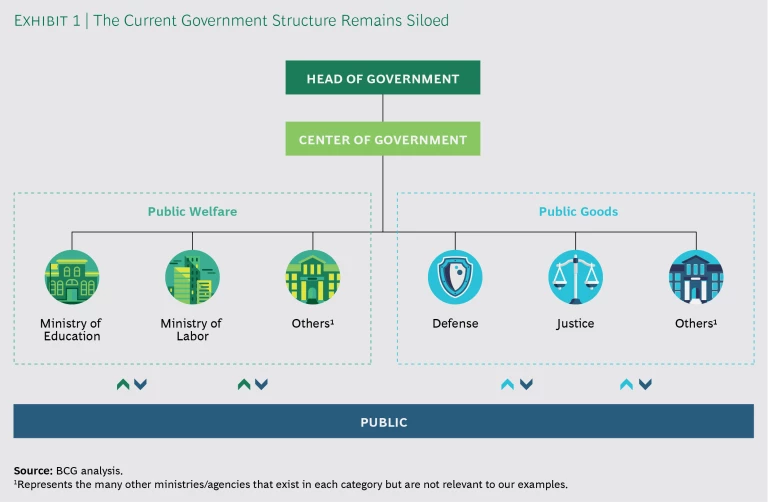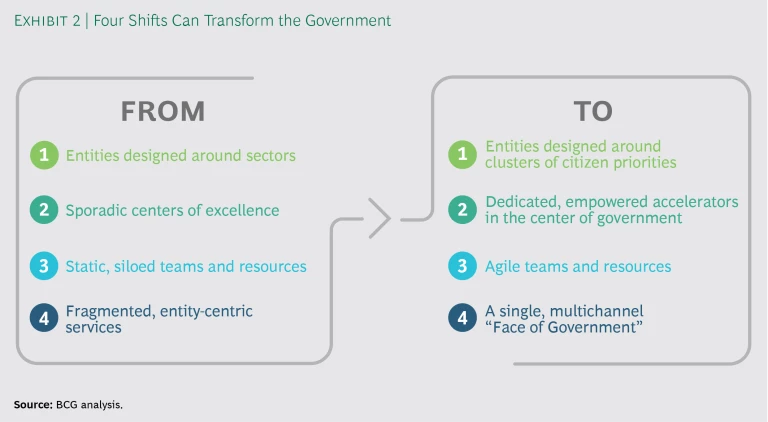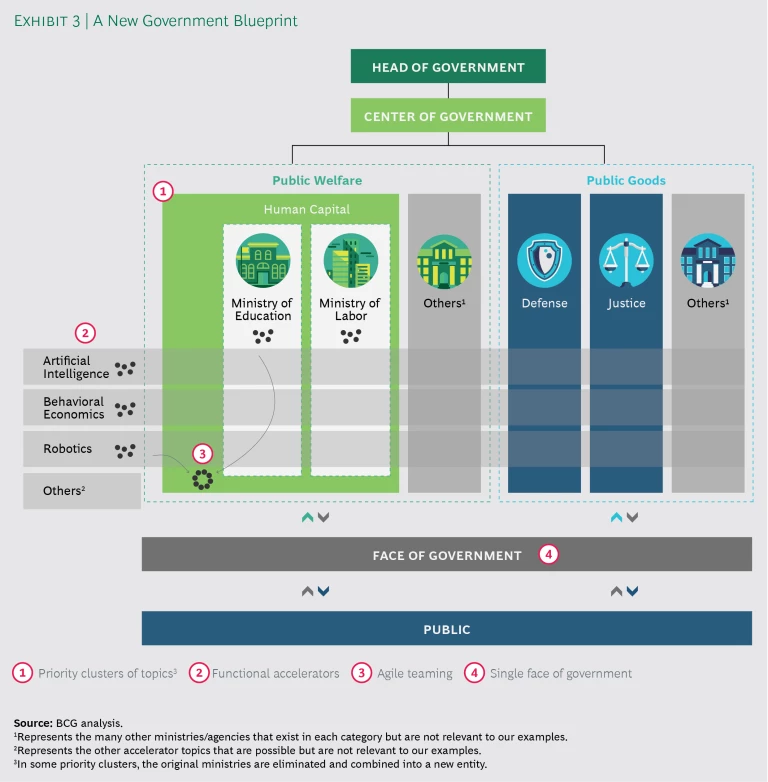Powerful forces are transforming society—and creating challenges for governments around the world. Citizens, now accustomed to the ease of buying products from Amazon or hailing rides from Uber, have greater expectations about the way their government should deliver services. In addition, as technologies such as artificial intelligence (AI) advance at a breakneck pace, government must respond to both the opportunities and the disruptions that result. (See Destination Unknown: Exploring the Impact of Artificial Intelligence on Government, Centre for Public Impact, September 2017.) Meanwhile, globalization is increasing the interconnectedness of countries and economies, creating a host of new “wicked problems”—complex and daunting challenges such as the refugee crisis and rapidly spreading infectious disease outbreaks—that require coordinated action from a large number of stakeholders.
So far, however, governments are not responding to these societal shifts. They continue to operate the way they have for centuries, with structures that are hierarchical, siloed, and bureaucratic. But the speed of social change is too great for most governments to handle in their current form. And the pace is likely to accelerate. The time has come to fundamentally re-examine and remake the structure of government.
We have identified four fundamental changes that governments should make to better meet today’s complex challenges. First, they should move away from silos and create priority clusters. These would span a number of traditional ministries and agencies and manage specific issues that affect citizens directly. Second, they should establish functional accelerators that build expertise in critical areas—advanced analytics or AI, for example. Third, they must adopt agile ways of working, using cross-functional teams to drive innovation through rapid experimentation and learning. Fourth, governments must redesign the way they interact with citizens, creating a streamlined, one-stop shop where people can access the services and assistance they need.
Governments that fail to adapt will be ineffective at providing solutions to the problems and concerns of their citizens. The solutions that are needed include a system for lifelong education that helps workers remain competitive in a rapidly changing labor market; clear and easy access to critical government services; and adequate safeguards and regulations in new or transformed industries. Ultimately, governments that come up short in such areas will see their legitimacy suffer; citizens will be more inclined to limit government resources and less willing to engage with their government. Governments that are able to transform will deliver more impact for citizens—and strengthen their credibility and standing with the public they serve.
Forces of Change
Rapid change is the norm today. The shifts outlined below have significant implications for governments and how they operate. (See “Governing in the Age of Disruption,” BCG article, January 2018.)
Rising Consumer Expectations
Mobile phones are ubiquitous—a fact that has completely altered what people expect in customer service. Consumers expect everything from their bank account to their transportation to be available at the touch of a smartphone. But as companies continue to up their game in customer service, the public sector is not keeping pace. BCG’s 2016 Digital Government Satisfaction Survey found that citizens in only 4 of the 22 countries surveyed were highly satisfied with the overall quality of government digital services.
As they aim to meet rising customer expectations, governments should ensure that five basic characteristics of digital service in the private sector guide their efforts:
- Digital First. Services like Airbnb and mobile-only banks are built from the bottom up, with digital as their core channel.
- Integrated Service Offerings. Companies like WeChat in China and Amazon in the US win customers by offering a broad range of services in a single place. Think about this in terms of retail, for example. Consumers have moved well beyond the shopping mall concept; they now prefer to go to a central app or website to get just about everything they need.
- Simple and User-Centric. Services like TurboTax in the US take a complex and tedious process and render it highly intuitive using great design. Amazon’s new brick-and-mortar grocery store in Seattle similarly offers consumers a seamless, easy-to-navigate experience.
- Omnichannel. Zappos is a common example of a company that is great in every channel. In the e-commerce market, companies focus in large part on website design. Zappos has excelled there—but has also built a top-notch call center for customers who have questions or complaints.
- Personalized. From hotel pillow menus to Netflix recommendation lists, services are becoming more and more customized. Customers expect companies to know what they want and to tailor service offerings to their specific needs and preferences.
Rapid Technology Advances
We’ve seen stunning technological progress over the past two decades. The emergence of the internet. The mobile revolution. The power of big data. But these innovations are likely just a prelude to radical technological changes now on the horizon. These include the takeoff of AI and rapid advances in fields such as nanotechnology and genomics.
In particular, AI, which encompasses machine learning, robotics, computer vision, and natural language processing, is poised to transform society in seismic ways. It will alter everything from how factories operate to how health conditions are diagnosed and treated to how people travel from point A to point B.
Governments must respond to technological change in two ways. First, agencies, departments, and ministries must fully harness the power of these technologies to improve their operations, policymaking, and service delivery. Second, they must develop regulations and policies that protect citizens from the nefarious use and adverse impacts of new technologies—think of fraud, for example, or job losses—while still establishing a framework that allows these technologies to flourish. Striking that balance will be difficult given the pace of innovation and the far-reaching impact in all corners of society.
Increasing Complexity
Traditionally, government has taken a straightforward approach to societal problems, one that breaks a problem down into its component elements and designs policies to address each piece. Today that approach is often doomed to fail because the problems at hand—and the potential solutions—are more complex than ever before.
Globalization is one of the drivers of that complexity. Problems in one corner of the world can quickly spread to other regions. The most intractable and complex of them—the wicked problems—have multiple causes, are constantly evolving, have significant ripple effects, and do not fit neatly under one government discipline or function. To address such problems, governments must design policies that cover multiple disciplines and that can be adapted as circumstances change—something they frequently struggle to do.
The Cost of Failure
As the forces of change gain momentum, government and citizenry will both pay the price if the public administration does not adapt.
Governments that fail to meet rising citizen expectations will diminish the reservoir of goodwill they have with constituents. Over time, that erosion in legitimacy can pose a significant risk to government.
Governments that fail to respond to technological change will likewise face major challenges. Unable to fully utilize the new tools, they will miss major opportunities to improve their own impact. In addition, they are likely to fall behind on the regulatory front. Case in point: the business models of companies in the sharing economy (such as Uber and Airbnb) became immensely successful before regulators could decide how to address them, precipitating social upheaval in some cities as workers in more traditional industries reacted.
At the same time, citizens will pay a steep price if their government does not adapt to technological change. According to the World Bank, about two-thirds of all jobs in the developing world are susceptible to automation, although the extent of job loss will ultimately depend on wage levels and the pace of technology adoption; in OECD countries, automation could replace nearly 60% of jobs.
Finally, governments that do not recognize and address globalization and increasing complexity will expend resources in ways that do not get to the root of the wicked problems they face. They will not be much help with their citizens’ most pressing concerns.
Four Powerful Shifts
To understand how the structural blueprint of the public sector needs to change, it is important to know the starting point for most governments.
Government traditionally has three principal components. The first is the head of government, such as the president, monarch, or prime minister, who presides over the entire structure. The second component is the center of government, which comprises all the groups that provide policy and administrative support to the government head, as well as policymaking bodies such as parliaments or legislatures. The third piece is the public administration, which is typically organized into ministries or departments that are responsible for policy areas such as education, health, and defense. Despite periods of reform, including shifts toward outsourcing or public-private partnerships, these entities frequently function much as they did 100 years ago. They are built largely around silos and their culture is hierarchical, process driven, and risk averse. (See Exhibit 1.)
We focus our recommendations on the public administration component of government. While the head and the center of government can vary considerably by country, the composition and function of public administration are similar throughout the world. In addition, public administration typically employs significantly more people and consumes significantly more resources than the government center. Consequently, changes to its structure and operation can have a sizable impact.
So how can public administration adapt to higher expectations, rapid technological change, and mounting complexity? We see four powerful shifts that can help. (See Exhibit 2.)
Organizing Around Priority Clusters
Public administration should be reorganized into priority clusters—policy areas that are connected or have significant overlap. These clusters should be defined by the everyday lives and needs of citizens. Education and employment are one example of a priority cluster. Health and welfare—which encompass health care, nutrition, social support, and retirement—are another. Certainly not all departments or ministries are candidates for a priority cluster. Some, such as defense or justice organizations—what we call “public goods”—might continue to operate best as distinct entities. But as complexity grows, the number of areas with overlap and linkages—and the strength of those interdependencies—will increase.
To understand how a priority cluster could function, we took a close look at education and employment. Policies, regulation, and public services in these areas are typically managed through separate departments or ministries—an approach that made sense for most of the 20th century. Over that period, people generally trained, entered a field, and then worked in that field for their entire life.
But the world has changed. As advances in robotics, machine learning, and AI accelerate, it is no longer realistic to think that people can work productively for decades after being trained to do a particular job. Of the jobs that today’s students will hold in 2030, it is estimated that 85% do not exist today.
In education and employment, the priority cluster could be called “human capital,” an entity responsible for setting policies that guide a citizen’s education and working life from cradle to grave. This cluster would focus on skills building for the modern workplace, encompassing early education, vocational training, lifelong learning, and services for linking people to jobs based on their skill set.
Although no country has yet made a structural overhaul to create priority clusters, a number have made reforms that encourage better cross-functional collaboration. To date, most rely on coordination committees or task forces. In some cases, governments have created dedicated positions to foster collaboration.
In the US, “czars” have been appointed to serve as policy advisors to the president on certain topics. President Obama, for example, appointed an energy and climate czar to advise him on those two related areas. The UK government recently made headlines with its announcement of a Minister of Loneliness to support the nine million people who say that they always or often feel isolated from society. The minister is expected to draw on resources from across the UK government, while the Office of National Statistics, in parallel, develops a concrete method for measuring loneliness.
Creating Functional Accelerators
The technology explosion has major implications for the skills required in government. More and more functions can now be automated, reducing the need for staff in purely administrative functions. At the same time, higher-level skills and greater expertise will be required across the entire government organization.
Governments can attack this problem by creating functional accelerators—centers of excellence that bring together talent and expertise in critical emerging areas such as big data and advanced analytics, behavioral economics, AI, and robotics. Accelerators plug in to other government functions or departments to help those groups master these new topics and build their own skill sets. Once the accelerator succeeds in embedding particular skills or technology know-how into all government units, it closes down or shifts to another topic.
Accelerators fill three important roles:
- Concept Incubator. Through their work at the cutting edge of their field, accelerators are familiar with emerging opportunities. They filter and refine those opportunities to ultimately propose the most viable ones for implementation.
- Technical Advisor. Accelerators act as talent pools from which teams across government can draw resources for developing new programs or policies.
- Research Hub. Accelerators leverage their experience to produce studies and reports, and conduct additional research, to advance their field or topic. This activity can be critical in ensuring that a country keeps pace with technology.
Some governments are already experimenting with the accelerator model. The UAE, for instance, has created a Ministry of Artificial Intelligence, charged with promoting AI both within and outside of government. In 2015, Canada set up an Impact and Innovation Unit within the center of government to help transform the operations of the public administration. The group works with government agencies and departments, as well as outside organizations, to develop innovative policies and programs, sometimes through the use of new financing approaches and partnerships. And the UK and the US have set up functional accelerators—the Government Digital Services unit and an operation called 18F, respectively—to advance their digital expertise.
Because the success of these accelerators will hinge in no small part on the expertise within government related to new technology, governments will need to more aggressively recruit talent from outside the public sector and to prioritize training in emerging technologies.
Introducing Agile Ways of Working
Keeping pace in an era of massive change requires new ways of working. One powerful tactic: the creation of cross-functional teams that can come together for a limited period to develop, test, and refine new programs and policies.
This agile way of working has its roots in software development in the 1990s. The philosophy is simple: give a team the space and autonomy to innovate, and organize the process around short cycles, or “sprints,” that focus on getting to a “good enough” solution—rather than perfection. The agile approach has spread far beyond software. Tech startups and corporations, from Spotify to GE, have scaled agile across their organizations. And even traditional industries like banking have embraced its potential. (See “Taking Agile Way Beyond Software,” BCG article, July 2017.)
In government, the agile approach would typically be best suited to complex problems whose solution requires expertise from a variety of groups. The team members would be drawn from functions or departments across the organization. And the duration of the effort would be anywhere from weeks to years.
The approach can be particularly powerful when used in the context of priority clusters. In an education and employment cluster, for example, a key objective might be to expand government’s role in retraining workers who lose their jobs to automation. Educators, job counselors, external industry experts, and professionals from the government’s big data and analytics accelerator could form an agile team. The team’s mission: develop a national campaign that identifies workers in at-risk jobs and provides them with retraining options. In parallel, a related agile team could work with private training companies and experts in emerging fields to create curricula.
Of course, many employees within public administration would continue to operate as they have. Police officers, nurses, and teachers, for example, would not be required to adopt agile ways of working, even if the nature of their jobs continues to evolve thanks to technology and other factors.
Establishing a Single Face of Government
The shifts described so far focus on improving the internal operations of government. The face that government presents to citizens, however, need not mirror the internal organization. In fact, citizens are often confused by government silos and don’t know how to manage them. And the teams within those silos typically struggle to communicate effectively with citizens.
Governments must rethink how they deliver services to their citizens. They should design service delivery on the basis of people’s needs, not the convenience of service providers. And as citizens increasingly expect integrated offerings, governments must move from providing services through a plethora of separate departments, agencies, and ministries to a single, one-stop-shop approach—what we call the single face of government.
The single face of government does not mean that all services should be offered through a monolithic website. Quite the opposite. This approach allows for the streamlined offering of many standard services—and the customization of services that require it.
To understand how this works, let’s look at two types of service. The first is the straightforward transaction (obtaining a building permit or opening a restaurant, for example). Many of these services are currently automated or in the process of being automated. And although most of them still require some human oversight, advances in AI will eliminate much of that human role in the future. Through the single face of government, these transactional services can be offered end to end, mainly via digital tools.
Government must also establish mechanisms to provide these services to all members of society—including those without access to digital channels. The right model depends on the characteristics of the region in question. In areas with concentrated populations that are not digitally savvy, it may make sense to establish a brick-and-mortar government service center—one that can help people conduct all government transactions. In places where the population is spread out over a large area, other approaches will be better. The government in Taiwan has created a corps of roaming civil servants who travel to rural areas to help people who lack access to or knowledge of digital tools.
Services of the second type are more complex. They involve a longer-term relationship between government and citizen, they do not follow a fixed process, and they require the expertise of highly specialized employees. These services include long-term unemployment assistance, drug addiction treatment, and prisoner reentry support. AI can improve decision making in such services, but a significant human element will likely remain. For example, AI may be used to create better matches between job counselors and job seekers, provide a more thorough screening of professional skills and needs, and identify training opportunities. But the job counselor will still be critical in providing motivation and guidance—though he or she may use AI-driven information and insight to provide tailored support. For complex services, the single face of government can connect citizens to the right departments or agencies. But specialists within those entities would manage the relationships.
Some forward-thinking governments have already begun to make the overall shift toward the single face of government. In the UK, for example, the websites of 25 ministerial departments and 385 other agencies and public bodies have been merged into a single website, Gov.uk, which has begun offering e-services. At the same time, recognizing that not all citizens will be comfortable engaging via digital channels, the UK government is also transforming how it delivers services through other channels, including phone and face-to-face interaction.
Bringing It All Together
The four shifts work interdependently to create a more effective, adaptive government. (See Exhibit 3.) The establishment of priority clusters helps government identify critical issues. Functional accelerators cultivate government expertise in rapidly advancing areas. Agile teams help harness that expertise to create new solutions to high-priority challenges. And the single face of government delivers those solutions efficiently to the people who need them.
Although these shifts can create a step-change improvement in the way governments operate, they are by no means the only adjustments required. Governments the world over are already making, and will continue to make, other important changes. They are becoming leaner through the adoption of shared services across functions and through the use of digital tools that improve efficiency and reduce headcount. They will increasingly leverage third-party, private-sector providers to deliver some government services. And they will continue to strengthen ties with local governments, which enjoy a closer connection to citizens and have, in many cases, proven adept at coming up with innovative solutions. Stronger ties between federal and local governments will benefit both.
How to Get There
Governments need to think strategically about laying the groundwork for change. The foundation must include broad political consensus and some early evidence of success. Public leaders can take three concrete steps to establish that foundation.
Step one: Establish the vision. Government must establish a vision that articulates both a strong case for transformation and the outlines of the new structure. The vision should identify which areas have significant overlap and are candidates for clusters, the types of accelerators needed, and the areas in which agile ways of working will be most useful. It should also spell out clearly the challenges and inefficiencies of the current government structure. Making a strong case for change can galvanize the civil service and build public support for the transformation.
The broad outlines of the new structure will differ according to a country’s politics and culture. The transformation is a long-term effort, and unforeseen developments are bound to arise. Painting a picture of the end state as a set of behaviors and principles—close coordination among related topic areas, for example—rather than as a detailed, predetermined architecture will allow for flexibility in the process.
Step two: Assign clear ownership of the restructuring effort. One group or entity must be tasked with driving the redesign. This group must be able to submit proposals to the head of government through a direct channel. To avoid conflicts of interest, it should be independent from other entities in the existing public administration and be empowered to request information from them.
There are a number of proven approaches to creating such an entity. Many countries already have units responsible for improving the structure and operations of the civil service. Others have created temporary structures to assist in large public-sector transformations, such as the Transition Planning Office in the US, which managed the launch of the Department of Homeland Security in 2002. Still others have established “delivery units” to drive the execution of key government priorities.
Step three: Build momentum. Many excellent ideas within government stall in the face of complex bureaucratic obstacles. To prevent that from happening, governments can take three actions:
- Create an initial set of priority clusters. Plans should be developed and executed early to create two or three high-priority clusters. These efforts will be in areas where tough challenges exist and where the impact on citizens is direct and signficant. The vision-setting process identifies the areas that are the best candidates for combining into clusters. In some cases, the overlap between departments or ministries will be so extensive that it will make sense to merge them into a single new entity. In other cases, the overlap will not be as obvious or extensive, but grouping into a new cluster will improve communication and coordination on critical shared topics.
- Begin the move to a single face of government. Governments should do some preliminary research to understand what citizens need from their government and how they currently go about accessing those services. Armed with these insights, governments can identify where service offerings can be consolidated and simplified. Creating a single government hub along the lines of the Gov.uk website is a good starting point. The work of integrating all data and systems on the back end can follow once that single face of government is established.
- Plant the seeds of agile across government. An agile functional accelerator, an entity that can help government build expertise and talent in agile approaches, should be quickly established. A few departments or agencies should pilot agile approaches; their efforts can be powerful test cases for other government units. In these pilots, teams address important issues or problems (improving a particular service or program, for example). Each team should include agile professionals from the accelerator, as well as other relevant public- or private-sector experts from fields such as technology, innovation, or behavioral economics. The accelerator should ensure that all top managers in the units that are running pilots have been trained in agile so they can use the principles on an ongoing basis.
Remaking the government structural blueprint is an ambitious undertaking. But government leaders need not attack the problem all at once. They should view the process as a journey and take some initial steps, quickly creating some priority clusters and launching pilots that can build government expertise in critical new areas. Experiment, get proof of concept, and build buy-in for the overall effort. The time for discussion is long past—it is time for action.









